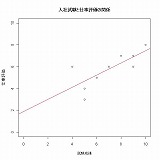放送大学「心理統計法」第12章 回帰分析
|
|
| Estimate | Std. Error | t value | Pr(>|t|) | |
|---|---|---|---|---|
| (Intercept) | 1.9111 | 1.2452 | 1.53 | 0.1634 |
| x | 0.5556 | 0.1717 | 3.24 | 0.0120 |
|
|
| Dependent variable: | |
| y | |
| x | 0.556 (0.172) |
| Constant | 1.911 (1.245) |
| Observations | 10 |
| R2 | 0.567 |
| Adjusted R2 | 0.513 |
| Residual Std. Error | 1.030 (df = 8) |
| F Statistic | 10.471 (df = 1; 8) |
| Note: | p<0.1; |
|
|
| Model 1 | |
|---|---|
| (Intercept) | 1.91 (1.25) |
| x | 0.56 (0.17) |
| R2 | 0.57 |
| Adj. R2 | 0.51 |
| Num. obs. | 10 |
| **p < 0.001, *p < 0.01, p < 0.05 | |
回帰直線を描く
|
|

線形モデル(切片を0にする)
|
|